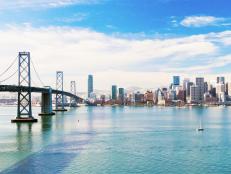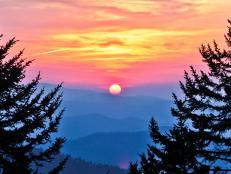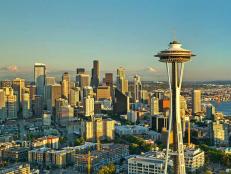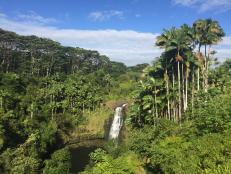Top Golf Getaways in the US

Chris Condon/Getty Images
The Pacific Northwest has always been known more for being the damp, windy corner of continental America than a destination for golfers. In recent years, however, a pair of outstanding courses in Oregon and Idaho, as well as one just outside the region in Northern California, have made the nook a desirable place for avid golfers. The sometimes-wet conditions may not be the most comfortable for playing a round, but they are responsible for creating the breathtaking backdrops and lush topography that can be found in these expertly designed courses.
Pebble Beach; Pebble Beach, California
Pebble Beach is the holy grail of golf -- widely regarded as one of the top ten golf courses in the world. Located just two hours south of San Francisco, Pebble Beach boasts magnificent views of California's lush Monterey Peninsula. Since 1919, Pebble Beach has been the luxury golf destination of choice for pro golfers and celebrities looking to unwind. The challenging golf course, designed by Jack Neville and Douglas Grant, snakes around the jagged Northern California coastline and offers unforgettable views of Monterey Bay. The layout of the course poses some unique challenges for the average golfer. The first two holes at Pebble Beach are located inland, the third runs toward the ocean and the fourth and fifth holes run along the coast. The eighth hole begins at an elevated tee. Players hit straight out toward the Pacific Ocean, with nothing in the foreground but ocean waves. Unlike most modern golf courses, the ninth and tenth holes do not return to the clubhouse. The memorable 18th hole features a tree in the middle of the fairway and a long bunker running along the ocean from the green. Pebble Beach hosts a variety of world-class golf tournaments including the U.S. Open and the annual AT&T Pebble Beach Pro Am.
Coeur D'Alene; Coeur D'Alene, Idaho
Stereotyped as a state known more for mashing potatoes than mashing 280-yard drives, Idaho is quickly gaining golf notoriety thanks to Coeur D'Alene. The top course in the state, and one of the best in the country, is made up of nearly 7,000 yards of gorgeous fairways and greens. Designed in 1991 by Scott Miller, it was quickly recognized in the sport as being both challenging and aesthetically impressive. The course's fairways and roughs carefully sidle along a lake and adjoining creeks, respective of the flora and fauna that interact with them, rather than barging through their natural home. Still, the most unique aspect of Coeur D'Alene is actually found at the end of the 14th hole: a unique floating island green. While island greens aren't uncommon in American golf courses, this is one of a kind. Before they pull out their putter to complete the hole, players must jump on a wooden shuttle boat to get closer to the pin. Should they play a second round at the course, however, they'll find that this boat will take a very different route to the 15,000 square-yard patch of grass. That's because Coeur D'Alene boasts the only floating and movable green in the country.
Olympic Club; San Francisco, California
California isn't exactly in the Pacific Northwest, but San Francisco is pretty close, right? At least close enough to include the much heralded Olympic Golf Club in this list. The club consists of three very unique courses: the Lake course, the Ocean course and the Cliffs course. While the names may not be the most imaginative, the layouts definitely are. The general consensus among golfers and critics on the best of the lot is the sloping, tree-filled Lake course. Golfers unafraid to have their 14 handicap turn into 60 can take on the short Cliffs course. The course's dramatic bluffs overlooking the mighty Pacific feature thrashing wind gusts that wreak havoc on approach shots -- a definite challenge for even the most accomplished players. Finally, there's the Ocean course. The poor greens have been repeatedly beaten by various storms (most notably those caused by El Nino in the 1990s), but it remains the longest of the three courses despite numerous re-constructions.
Pacific Dunes; Bandon, Oregon
Pacific Dunes exudes class and sophistication. Compared with the well-established courses in the States, Pacific Dunes is a relative infant as a golf course. It was erected in 2001, under the direction and design of Tom Doak. Today, along with its sibling Bandon Dunes next door, Pacific Dunes has risen in the ranks of top American courses. Much like Olympic Club, Pacific Dunes uses the rough ocean as the aural and visual centerpiece for many of its 18 holes. But it is also victim to the same capricious winds that golfers must battle in Olympic Club's Cliffs course. When players do get a chance to lower their shielding hands from their faces, they'll find that Pacific Dunes is truly a ruddy golf gem. The topography changes almost as violently and frequently as the wind, making the fairways look like small green oases gently placed on the craggy outcroppings. Natural bunkers book-end half a dozen of the holes and impress those who luckily avoid them while frustrating the majority of players, who slice their shots into them. Thankfully, the overall brilliance of Pacific Dunes manages to salve even the most frayed nerves.


























.jpg.rend.hgtvcom.231.174.suffix/1674758726773.jpeg)











